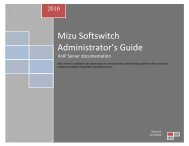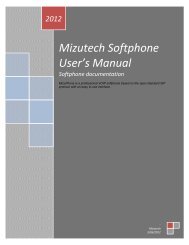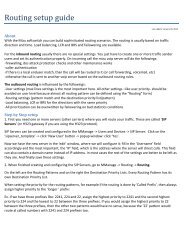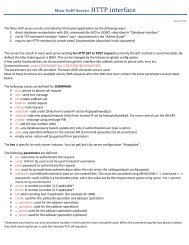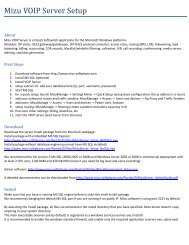Admin Guide - Mizu Voip
Admin Guide - Mizu Voip
Admin Guide - Mizu Voip
- No tags were found...
You also want an ePaper? Increase the reach of your titles
YUMPU automatically turns print PDFs into web optimized ePapers that Google loves.
-and many othersSince all data is stored in the SQL database, you have to protect only your database (the program directory can be recreated anytime by simplefile copy or reinstall. Only the database path is stored here in the mizuserver.ini file which need to be reentered correctly after a restore).Although there is no special maintenance needs with the mizu server, to have a working backup is a very important task to be set and testedproperly. The mizu server will automatically create backups on the same server (without any additional settings), but for a real backup youhave to change the backup directory to another physical location.For more reability you should use the MS SQL backup related capabilities instead of using the mizutech built-in backup methods.3.5.2. What is a backup?A backup refers to making copies of data so that these additional copies may be used to restore the original after a data loss event. Backups are usefulprimarily for two purposes. The first is to restore a state following a disaster (called disaster recovery). The second is to restore small numbers of files orrecords after they have been accidentally deleted or corrupted.There are also many different ways in which the data storage devices can be arranged to provide geographic redundancy, data security, and portability.Any backup strategy starts with a concept of a data repository. The backup data needs to be stored somehow and probably should be organized to a degree.Different repository models have different advantages. This is closely related to choosing a backup rotation scheme.Unstructured: An unstructured repository may simply be a stack of floppy disks or CD-R/DVD-R media with minimal information about what was backedup and when. This is the easiest to implement, but probably the least likely to achieve a high level of recoverability.Full + Incremental: A Full + Incremental repository aims to make storing several copies of the source data more feasible. At first, a full backup (of all files)is taken. After that, any number of incremental backups can be taken. There are many different types of incremental backups, but they all attempt to onlybackup a small amount of data relative to the full backup. Restoring a whole system to a certain point in time would require locating the full backup takenprevious to that time and the incremental backups that cover the period of time between the full backup and the particular point in time to which the systemis supposed to be restored. The scope of an incremental backup is typically defined as a range of time relative to other full or incremental backups. Differentimplementations of backup systems frequently use specialized or conflicting definitions of these terms.Differential: A differential backup copies files that have been created or changed since the last normal or incremental backup. It does not mark files ashaving been backed up (in other words, the archive attribute is not cleared). If you are performing a combination of normal and differential backups,restoring files and folders requires that you have the last normal as well as the last differential backup.Continuous data protection: Instead of scheduling periodic backups, the system immediately logs every change on the host system. This is generally doneby saving byte or block-level differences rather than file-level differences. It differs from simple disk mirroring in that it enables a roll-back of the log andthus restoration of old image of data.3.5.3. Built-in database backupYou can configure your database engine to do the backup tasks. If you don’t have this possibility, the <strong>Mizu</strong> Server can also make database backups. Set thefollowing configurations:




